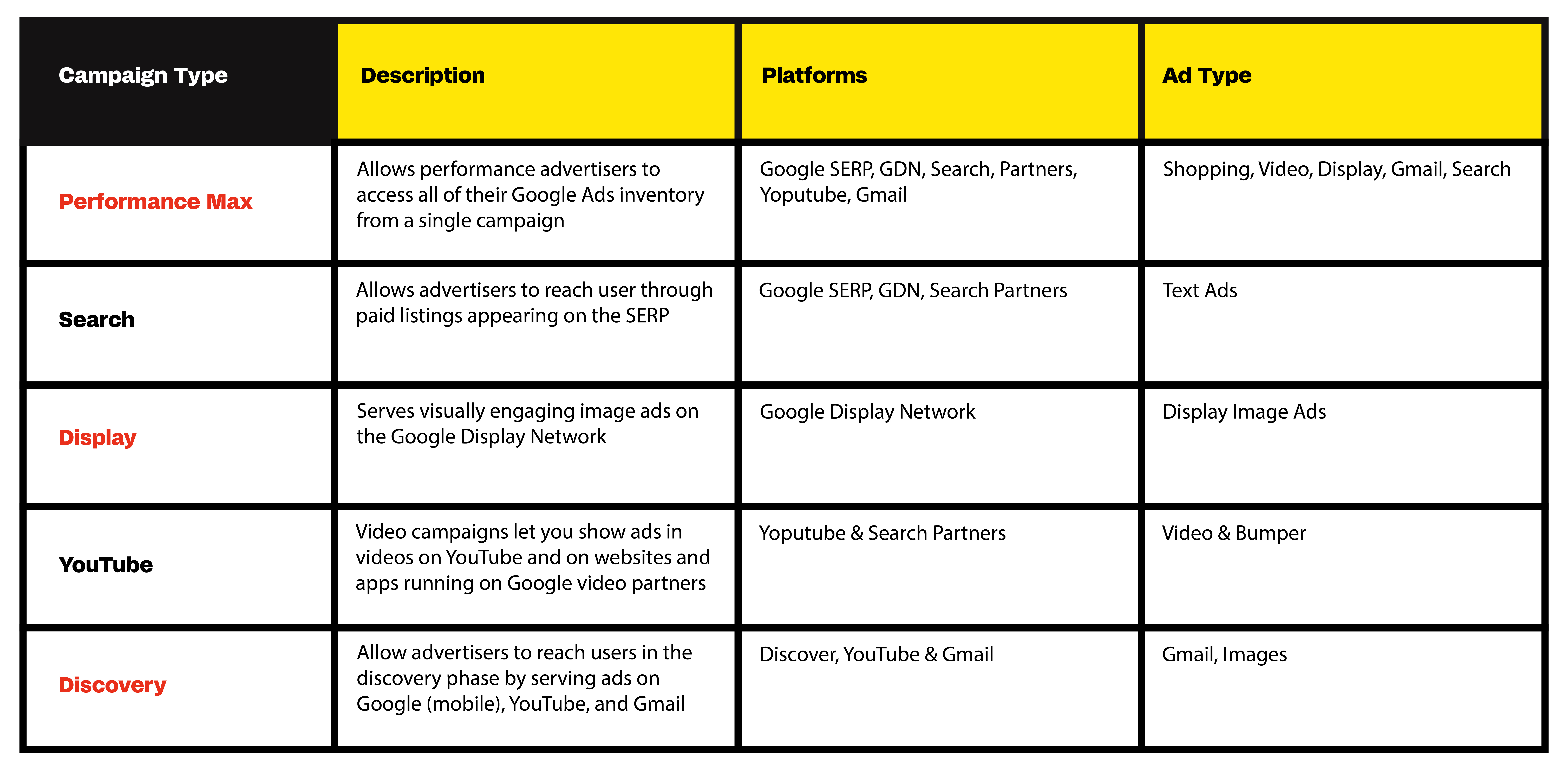It’s no secret that Google’s been working toward a more automated platform with each new tool they release, and their new Performance Max campaigns are no exception to this. Performance Max campaigns are the newest addition to the Google advertising landscape, having just recently launched to all advertisers after a lengthy beta period.
In this article, we’re breaking down everything you need to know about Performance Max campaigns — including a breakdown on how these campaigns operate, how to set them up, the pros and cons, and how you can leverage them to drive success based on your goals! If that all sounds good to you, keep reading to learn how you can take your performance to the max with Performance Max campaigns.
What Are Performance Max Campaigns?
According to Google, “Performance Max campaigns allow you to promote your products or services across the Google Network by creating one easy-to-manage campaign.” In other words, Performance Max campaigns offer single-campaign optimization opportunities across multiple Google advertising platforms, which include: paid search, shopping, display, YouTube, and Gmail. The way this campaign functions is simple: the advertiser provides various assets appropriate for each channel including video, display ads, a shopping feed (if applicable), and ad copy featuring multiple headlines and descriptions. From that point on, the work needed on the advertisers’ end is significantly less, while the bulk is left to Google’s AI to pick, choose and test assets that work best.

Who Should User Performance Max Campaigns?
Without a doubt, Performance Max campaigns will be utilized by all Google-based marketers at one point; however, these campaigns are notably useful for in-house advertisers and those looking to set up a simple Google campaign without having to dive too deep into strategy. With Performance Max, advertisers are easily able to run ads across multiple channels with little lift and optimizations needed. Performance Max campaigns use a holistic approach to drive as much success as possible with the assets provided while utilizing Google’s AI bid strategies.
Optimizing Toward Your Goals Using Performance Max
Performance Max campaigns are currently limited to the types of goals they can be optimized toward. At the moment, these campaigns are available to advertisers looking to drive sales, online leads, or to drive users to a storefront. Goals that are currently not available to Performance Max campaigns include engagement, app promotion, product & brand consideration, and brand awareness & reach.
Optimizing Toward Sales
When optimizing for sales, advertisers have the opportunity to run Google Shopping ads alongside other Google-offered channels. With sales-optimized campaigns, advertisers can optimize toward sales, max conversion value, and add a target ROAS. If you’re looking to utilize this campaign for shopping ads, make sure your feed is ready to go in the Google Merchant Center.
Optimizing Toward Leads
Advertisers looking to drive leads can do so through every platform excluding Google shopping. Assets provided should have a strong CTA that incites ad viewers to perform a specific action, and campaigns will automatically optimize toward a max conversion goal.
Optimizing Toward Store Visits (Beta)
Performance Max campaigns can drive physical store visits. Though the newest of all campaign strategies, there is an opportunity to drive store visits. To do so, set up a Performance Max campaign and then select store locations as your campaign feed. NOTE: Campaigns with a store visits only goal will be in Beta until 2022.
Setting Up Performance Max Campaigns
As we’ve already talked about, Performance Max campaigns are relatively easy to set up; however, we do recommend having a strategy in place before diving into this. Performance Max campaigns are broken down by asset groups, which are “a collection of creatives centered on a theme or related to a target audience.” In other words, asset groups are defined by the audience you choose to target and the assets that match your targeted audience.
What Assets Do You Need?
Asset groups consist of a variety of assets Google utilizes to reach all channels, including Search, display, youtube, Gmail, and shopping. With that being said, for your Performance Max campaign to reach all channels, Google recommends these specific assets to get started:
Text Specifications
- 1 Final URL
- Up To 5 Headlines
- One headline should be 15 characters or less, while the others should stay under a 30 character limit
- Up To 5 Long Headlines (90 character limit)
- Up To 5 Descriptions
- One description should be under 30 characters or less, while others should stay under a 90 character limit
- 1 Business Name
- 1 Call-To-Action
- Shop, Learn More, Visit Us, Etc…
- Up To 2 Display URL Paths
Image Specifications
Each asset group can contain a total of 15 photos and 5 logo images. Some recommended image formats:
- 3 Landscape Images
- 3 Square Images
- For store visits, use 1 square image
- 1 Portrait Image
- 1 Square Logo
Video Recommendations
Video is required for all Performance Max campaigns. If videos are not created, they’ll likely be generated based on other assets provided in the campaign. As a best practice, videos should be greater than 10 seconds long.
Looking for more tips on constructing the perfect YouTube ad? Learn more.
About Audience Signals
On top of providing assets to the asset group, Google recommends providing an audience signal as well. According to Google, “Audience signals allow you to add audience suggestions that help Google Ads automation optimize for your selected goals.” Though audience signals are not essential to campaigns, they are a Google-recommended best practice that will likely impact your overall optimization score.
The Pros of Performance Max Campaigns
Without a doubt, there are a ton of benefits Google offers to advertisers through their Performance Max campaigns. As we’ve talked about, Performance Max campaigns are the simplest way to reach multiple channels in one singular campaign, making for an improved user experience and easy campaign management.
Ease of Setting Up
Rather than creating separate campaigns for separate channels, Performance Max campaigns are relatively seamless to set up. After setting your standard budget, location targets, and choosing your preferred campaign settings, assets are uploaded in one singular area (see below).

With all assets uploaded in one place, the campaign presents how ads will be displayed on each channel. This is also a great way to see how your assets interact with each other, and if they convey the messaging you were looking for. The only thing needed beyond this point are extensions, which are not essential to activating the campaign.
Result-Driven
Like other Google automation features, Performance Max campaigns are naturally performance-driven. With this automation, Google’s AI automatically tests creativity and serves top-performing creative on top-performing channels based on its findings and what’s the most likely to convert. If you’re looking to hit specific targets, Google automatically optimizes toward the most conversions. For eCommerce-based campaigns, advertisers can take optimization a step further and optimize toward conversion value and target ROAS.
Holistic Approach & Full Channel Coverage
For most advertisers looking to take advantage of all of Google’s offered channels, this is without a doubt the biggest pro of utilizing a Performance Max campaign strategy. As stated, these campaigns are the most simple and straightforward way for advertisers to market across a number of different channels in one singular campaign, rather than running multiple campaigns across various channels.
Location & Ad Schedule Visibility
Despite having lesser optimization and insight opportunities compared to channel-specific campaigns, Performance Max campaigns do offer both location and ad schedule adjustments. This is essential for targeting your ideal location at top-performing times, and a feature all advertisers should take advantage of.
The Cons of Performance Max Campaigns
Despite offering a variety of benefits for advertisers, it’s important to note that Performance Max campaigns fall flat in a few areas — primarily in terms of campaign management and performance visibility. Let’s break it down:
Visibility & Transparency
Like other Google-automated campaigns, Performance Max campaigns are a black box. Though Google makes an effort to provide insight on top-performing audiences and rates ad creative on a “Great, Good, and Low” basis, there’s not enough data to highlight conclusive results about what’s working and what’s not. Not only are advertisers limited to the data Google chooses to provide, but there is also little to no visibility on channel-specific performance and how exactly the provided assets are being utilized. As these campaigns are new to the Google landscape, we’re hoping to see some drastic changes and improvements here.
Bid Limitations
Not only are insights limited, but there are specific bid limitations here. Performance Max campaigns are limited to one bid strategy – maximize conversions. With that being said, eCommerce accounts have the ability to choose “maximize bid strategy” and set a target ROAS, but that’s about it. If you were hoping to have more control over how your budget is spent or your CPC’s, look elsewhere and toward more channel-specific campaigns.
Cannibalizing Channel-Specific Campaigns
As stated above, Performance Max campaigns are a bit of a black box, meaning we have little to no visibility into performance, and notably – channel-specific performance. With no insight on where ads are served and how they’re converting, there’s no way to be sure these campaigns aren’t cannibalizing your other campaigns and leveraging the most successful keywords, placements, and audiences that have driven historic success. If you plan on running a Performance Max campaign alongside channel-specific campaigns – keep a close eye on how this impacts your performance both holistically and channel-specifically.
Asset Level Performance
Unfortunately, asset groups do not function the same way as ad groups do. There’s no way to evaluate how one asset group is performing over the other. In other words, there’s no way of knowing if you should pause the entire group on continuing to run it, with no insight on audience or hard data on creative performance. As marketers aim to be as data-driven as possible, this feels like quite a setback in terms of making the right decisions to drive optimal results.
Though audience insight is limited at the asset group level, the good news is that you can evaluate asset-level performance on the product tab, where you can evaluate product-specific performance. On the tab, the asset group is listed next to the product that was served.
Inability To Negate Keywords
If you thought you could prevent channel cannibalization by negating the keywords you’re already bidding on, think again. Performance Max campaigns do not allow for negative keywords or the application of negative keyword lists.
Limited Targeting & Audience Targeting
Beyond choosing audiences for your asset group, it’s difficult to evaluate audience performance. Like I mentioned above, asset groups provide virtually no insights on performance, and audience performance is no different. If you choose an audience signal for your asset groups, you won’t receive much information on performance outside of product performance. With that being said, make sure your audience signal is relevant to your product as you want to make sure you’re reaching users who could benefit from its use.
Device Limitation & Testing
Device performance and bid adjustments are a key part of optimizing Google campaigns, especially for advertisers looking to test mobile vs. desktop performance. Beyond the inability to implement device modifiers, Performance Max campaigns have yet to release information of device-specific performance, giving no clarity on performance. As a workaround, we recommend using analytics for all your device insight needs, but we wish Google would release it within their advertising interface.
Performance Max Best Practices
As we’ve had time to test Performance Max campaigns, we’ve put together a list of best practices and considerations for advertising looking to run a campaign.
Utilizing Audience Signals
Your audience signal determines who your ads appear to, regardless of the channel. Google recommends pairing an affinity/interested-based audience with a custom audience (Site visitors are a great one). Based on this audience selection, Google’s AI will begin to target users within this audience, while identifying users similar to this audience to target.
With that being said, not every converting user may fall into this category. Consider testing an asset group without an audience signal. For example, we noticed with audience signals and specific targeting, our shopping ads were not appearing to all users searching for the brands’ Trademark. After removing the audience signal, we were able to reach a larger audience with little impact on our ROAS. To ensure campaigns weren’t affected, we placed a target ROAS to maintain a level of campaign safety.
Choosing Assets
After deciding your target audience, ensure assets correlate with that same audience. Though gender brand awareness assets will perform well, it’s great to take things a step further to make sure you’re fully making the potential customer aware of how your brand fits their needs. For example, if you’re targeting users with curly hair to sell your hair product, consider having a mix of assets relevant to a curly-haired audience.
On top of relevant assets, always include promotional assets as well (if applicable). Sales, savings, and free shipping deals are some of the best ways to drive a click, and Performance Max is no different. Despite having limited insights into asset performance, value props are always rated as top performers.
Monitoring Your Performance Max Campaigns
Like most Google campaigns utilizing automated bidding strategies, they take around 14-30 days to ramp up post-approval. We’ve already talked about how Performance Max campaigns are a black box, so let’s look at what you can do to monitor and assess performance:
Utilize the Insights Tab
The insights tab is sometimes overlooked by marketers, but should not be neglected when reviewing your Performance Max campaign performance. Within the insights section, you can find a mix of top-performing audience segments and top audience themes. Though there are few immediate optimizations to be made based on these insights, consider taking these learnings and applying them to your other channel-specific campaigns (if applicable).
Product-Specific Performance
Good news for eCommerce marketers, with the migration from smart shopping to Performance Max campaigns, not all shopping insights are lost – they actually stay on par with the amount of visibility received via smart shopping. On the products tab, marketers are able to see which products are performing well in their respective asset group and can pause, enable, and break out partitions accordingly.
Extension Performance
If you previously added extensions to your Performance Max campaign, the extensions tab allows you to review their performance based on a few metrics: Impressions, cost, and clicks. Though data is limited, you have the opportunity to improve these if the data dictates it.
Location & Ad Schedules
If you added targeted location and ad schedules when you launched your campaigns, make sure that you always consistently check in on the performance. Advertisers have the option to add positive and negative modifiers here. Despite the fact Google’s AI already optimizes for you, these tabs still provide valuable insight on performance and give the option to easily exclude or scale back as needed.
eCommerce Campaigns & The Future of Smart Shopping
As Google continues to grow and evolve its advertising landscape, we’re seeing more and more of its earlier features phased out and replaced with newer, more advanced strategies. With that being said, Smart Shopping will be phased out in 2022. Though advertisers will no longer be able to create smart shopping campaigns, they will be able to maintain their current campaigns. Smart Shopping has been a valuable asset to eCommerce marketers for years, and we’re looking forward to watching the space evolve as more marketers migrate their efforts into Performance Max campaigns.
As a best practice, we recommend getting ahead of the curve before smart shopping is completely phased out. Though advertisers will be able to maintain their campaigns, it’s no secret that Google likes to prioritize their newest innovations, and advertisers not migrating before the phase-out date run the risk of devaluing their efforts. On top of this, it’s important to familiarize yourself with this new format.
Though Google recommends providing assets for all channels offered via Performance Max, it’s not necessary. If you’re looking to run only a shopping campaign, the only asset you’ll need is your feed connected through the merchant center. From the feed, Google will generate ads based on product feed imagery, similar to the way smart shopping works now.
Performance Max Campaigns & The Future of Google Marketing
To most marketers that have used Google’s advertising platform before, it’s no surprise that with each new release, campaigns become more and more automated. Notably, with Google’s recent announcement that they will be phasing out expanded text ads and smart shopping, it’s obvious automation is being pushed more now than ever. ETA’s and smart shopping are two assets that have been essential to marketers over the course of the last few years, and assets that aren’t very dated to begin with.
Performance Max campaigns are the most automation-driven campaign type we’ve seen thus far, and we can’t wait to see what’s next. Though there are valid concerns about this new campaign type, we’ve seen promising results and will continue to test to drive success for our partners. As Google continuously introduces new products while phasing out the old, we’re embracing this new era of automation and all the success it offers.






